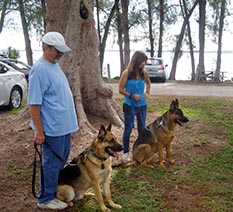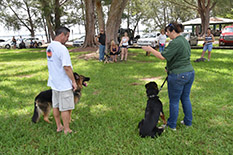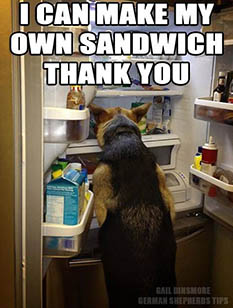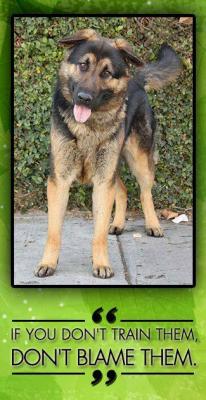TREATS TRAINING AND TIMING
- Thursday, February 04 2016 @ 10:10 pm UTC
- Contributed by: erik
- Views: 2,739
TREATS TRAINING AND THEIR CORRECT TIMING AND DELIVERY
BY ERIK HOFFER TRAINING TREATS AND TIMING
By Erik Hoffer
Dogs associate treats with being rewarded for an action if they are delivered correctly. Timing of the delivery is critical to its effectiveness. If delivered correctly the treat does its job to reinforce a particular behavior and enhances the effectiveness of training. If they are delivered incorrectly then they are just simply a treat and the association with the desired behavior is all but lost. This applies to clicker training, verbal rewards, physical rewards like petting or ear rubbing, when your dog performs a task or command as he should. This article deals with the treats themselves, the timing in which they are delivered, the delivery methods and the effectiveness of using treats to reinforce trained behaviors.
Positive reinforcement is by far the most effective way to train your pet. Whether the dog is a German Shepherd or a Mastiff training is the only way your pet can learn most any behavior or understand direction. Just because you may have an older pet and now you have acquired a younger one, the older one can only be a guide to behavior for the sibling, and should in no way be the one to teach nor can they correct behaviors of the new family member. Only you can provide direction and reward for these new behaviors or expectations.
Treats and praise, happy voice and physical rewards all play an important role in teaching your new pet to become a family member and a canine good citizen. Treats, in my way of thinking, have a hierarchy of reward. Although a treat is munched and swallowed in milliseconds, it is a great tool to convey pleasure and approval to your pet and to reinforce other behaviors simultaneously. Pets will work for rewards and tasty treats are great at first but should be diminished as your dog perfects the tasks you are teaching. At some point where the dog has learned the desired skills, a verbal treat is all he needs along with a pat on the head or a hair muss to know you approve and that he did well.
We use chicken as a high reward treat, Kosher hot dogs as an intermediate treat and string cheese as a general reward. Chicken breasts can be cut widthwise and fried in a pan so you have a ¼ inch flat piece of chicken which can be cut into ¼ x 1/2 inch strips. These are placed in a baggy which is then put into your training or fanny pack. Hot dogs are done in 1 minute in the microwave and then cut lengthwise into 4 strips and then into ¼ x ¼ inch cubes. No Bigger! String cheese comes out of the packet and can also be put into the fanny pack and torn off or bitten off by you before delivery to the dog. While training, which implies motion, never give your dog a treat that he has to chew. Never give them a crunch treat because they will not be able to chew it and can choke on it. Tiny moist training treats are fine (if you know what they contain) because these are usually ¼ inch cubes and easy to swallow. If they get hard, don’t use them for active training rewards.
Now that you have your treats in a fanny pack around your waste, you are prepared to deliver these when your dog performs the action required. Do NOT ever give dogs treats directly from the fanny pack because that is on your waist. If the dog looks at your hand and waist each time he knows a treat is coming you have defeated 50% of the treats training value. Treats come from your NOSE. Bring each morsel of training food from the pack to your nose such that the dog looks into your eyes before he is rewarded. He will quickly get use to looking at your eyes and face awaiting a command and then followed by a treat. By making eye contact with each treat you reinforce the desired behavior, reinforce who is giving the dog the reward and you facilitate the dog interacting with you which is a very pleasurable experience for him.
Treats can also be accompanied with verbal praise, such as good boy, good job, (or name recognition) such as good boy Duke, good job…. Then treat him. Treats are delivered immediately after the action, just like negative feedback needs to come immediately or even while the dog is doing something bad, positive reinforcement needs to come equally as fast so as to reinforce the basis for the treat and reward the activity then and there. Waiting even a second after the action fails to get the dog to associate the action with the reward. To the dog waiting a second after the act means that the action was something in the past and now I am getting a treat from daddy, but I am not certain why. Clicks from clicker training needs also to come immediately. As an example, you say Duke sit, by the time his ass hits the pavement you need to have the clicker clicked. After he sits and again immediately after his butt is planted he needs to get the treat and the verbal confirmation of “good boy”. By using timing practice drills you will be able to get your timing and his action at a level where he understands what the treat is for.
I briefly spoke about positive reinforcement type training vs negative reinforcement. If you are insane enough to use a shock collar on your dog, try it on your wife first. If she thinks it works then go right ahead, but if she doesn’t think that it works move to our methods of positivity.
Here’s what we do that may be somewhat different from other training methodologies. Since we work with rescue dogs, we really never know what they know nor how they were taught. If we say “sit” they may have been spoken to in Spanish where “sietate” means the same thing (my Spanish is non existent so this is a phonetic rendition and my authors license. He may also know “sitz” which is a German command. When we say sit he may not comply so we try and find something he does know in the same command moment. If he makes eye contact, you can treat him and say good “watch me”. If you place his butt on the ground with your hand, you can also say “good boy, good sit” and you treat him thereby reinforcing the sit command. If he is a new dog or has a new name, you can use “good sit Fido, good sit” as a pre-treat verbal reward. Regardless of the command, try and find something positive to say when you are training so as to make the training fun and using the time as a bonding experience and a mental challenge for your dog. You can milk each command and reaction and every moment with your pet as an opportunity to teach him various things simultaneously.
German Shepherds, like many of the other ‘smart’ breeds are like 4 year olds. They respond to a happy (high pitched) voice, love receiving visual reinforcement and food rewards. They learn exponentially with these techniques and I assure you they will sleep well that day after training. Mental stimulation coming with the animal’s ability to associate your pleasure with his actions is the right road to training at every level. The more he likes what’s happening the more excited he becomes in learning new things. This will last a lifetime.
When pets learn they need to be in an environment that challenges them. Teaching your dog to get the newspaper in your home is quite different from retrieving an item in a park where there is a considerable amount of activity, other people and pets and cars and people. The more sterile the environment the easier it is to get the animal to do what is being asked of him. In most cases if the dog can do it at home, he many not (80%) of the time be able to accomplish that same task when at the park. Home training is only a part of any training regimen and needs to be supplemented by socialization classes where distractions are the norm and his need to listen and obey far more acute. When training, regardless of venue, the dispensing and reward mechanisms are identical. First command then immediately treat or praise. In a park where noise is normal, your dog needs to look to you to know what you are saying. Make sure before you get into a crazy training program that you work on the Watch Me command where the dog makes eye contact. This is basic to the treat coming from your nose where the dog expects a command when he hears your voice and then expect positive reinforcement when he accomplishes it, be it food or verbal affirmation of the good job he did.
Make learning fun and maximize your training time with your dog for at least 4-6 months after getting a rescue dog. He will gladly show you his triggers, his anxious points and places, his ability to learn and his capacity to learn. He will make training equate to bonding and you both and he will never forget what he has learned.




BY ERIK HOFFER TRAINING TREATS AND TIMING
By Erik Hoffer
Dogs associate treats with being rewarded for an action if they are delivered correctly. Timing of the delivery is critical to its effectiveness. If delivered correctly the treat does its job to reinforce a particular behavior and enhances the effectiveness of training. If they are delivered incorrectly then they are just simply a treat and the association with the desired behavior is all but lost. This applies to clicker training, verbal rewards, physical rewards like petting or ear rubbing, when your dog performs a task or command as he should. This article deals with the treats themselves, the timing in which they are delivered, the delivery methods and the effectiveness of using treats to reinforce trained behaviors.
Positive reinforcement is by far the most effective way to train your pet. Whether the dog is a German Shepherd or a Mastiff training is the only way your pet can learn most any behavior or understand direction. Just because you may have an older pet and now you have acquired a younger one, the older one can only be a guide to behavior for the sibling, and should in no way be the one to teach nor can they correct behaviors of the new family member. Only you can provide direction and reward for these new behaviors or expectations.
Treats and praise, happy voice and physical rewards all play an important role in teaching your new pet to become a family member and a canine good citizen. Treats, in my way of thinking, have a hierarchy of reward. Although a treat is munched and swallowed in milliseconds, it is a great tool to convey pleasure and approval to your pet and to reinforce other behaviors simultaneously. Pets will work for rewards and tasty treats are great at first but should be diminished as your dog perfects the tasks you are teaching. At some point where the dog has learned the desired skills, a verbal treat is all he needs along with a pat on the head or a hair muss to know you approve and that he did well.
We use chicken as a high reward treat, Kosher hot dogs as an intermediate treat and string cheese as a general reward. Chicken breasts can be cut widthwise and fried in a pan so you have a ¼ inch flat piece of chicken which can be cut into ¼ x 1/2 inch strips. These are placed in a baggy which is then put into your training or fanny pack. Hot dogs are done in 1 minute in the microwave and then cut lengthwise into 4 strips and then into ¼ x ¼ inch cubes. No Bigger! String cheese comes out of the packet and can also be put into the fanny pack and torn off or bitten off by you before delivery to the dog. While training, which implies motion, never give your dog a treat that he has to chew. Never give them a crunch treat because they will not be able to chew it and can choke on it. Tiny moist training treats are fine (if you know what they contain) because these are usually ¼ inch cubes and easy to swallow. If they get hard, don’t use them for active training rewards.
Now that you have your treats in a fanny pack around your waste, you are prepared to deliver these when your dog performs the action required. Do NOT ever give dogs treats directly from the fanny pack because that is on your waist. If the dog looks at your hand and waist each time he knows a treat is coming you have defeated 50% of the treats training value. Treats come from your NOSE. Bring each morsel of training food from the pack to your nose such that the dog looks into your eyes before he is rewarded. He will quickly get use to looking at your eyes and face awaiting a command and then followed by a treat. By making eye contact with each treat you reinforce the desired behavior, reinforce who is giving the dog the reward and you facilitate the dog interacting with you which is a very pleasurable experience for him.
Treats can also be accompanied with verbal praise, such as good boy, good job, (or name recognition) such as good boy Duke, good job…. Then treat him. Treats are delivered immediately after the action, just like negative feedback needs to come immediately or even while the dog is doing something bad, positive reinforcement needs to come equally as fast so as to reinforce the basis for the treat and reward the activity then and there. Waiting even a second after the action fails to get the dog to associate the action with the reward. To the dog waiting a second after the act means that the action was something in the past and now I am getting a treat from daddy, but I am not certain why. Clicks from clicker training needs also to come immediately. As an example, you say Duke sit, by the time his ass hits the pavement you need to have the clicker clicked. After he sits and again immediately after his butt is planted he needs to get the treat and the verbal confirmation of “good boy”. By using timing practice drills you will be able to get your timing and his action at a level where he understands what the treat is for.
I briefly spoke about positive reinforcement type training vs negative reinforcement. If you are insane enough to use a shock collar on your dog, try it on your wife first. If she thinks it works then go right ahead, but if she doesn’t think that it works move to our methods of positivity.
Here’s what we do that may be somewhat different from other training methodologies. Since we work with rescue dogs, we really never know what they know nor how they were taught. If we say “sit” they may have been spoken to in Spanish where “sietate” means the same thing (my Spanish is non existent so this is a phonetic rendition and my authors license. He may also know “sitz” which is a German command. When we say sit he may not comply so we try and find something he does know in the same command moment. If he makes eye contact, you can treat him and say good “watch me”. If you place his butt on the ground with your hand, you can also say “good boy, good sit” and you treat him thereby reinforcing the sit command. If he is a new dog or has a new name, you can use “good sit Fido, good sit” as a pre-treat verbal reward. Regardless of the command, try and find something positive to say when you are training so as to make the training fun and using the time as a bonding experience and a mental challenge for your dog. You can milk each command and reaction and every moment with your pet as an opportunity to teach him various things simultaneously.
German Shepherds, like many of the other ‘smart’ breeds are like 4 year olds. They respond to a happy (high pitched) voice, love receiving visual reinforcement and food rewards. They learn exponentially with these techniques and I assure you they will sleep well that day after training. Mental stimulation coming with the animal’s ability to associate your pleasure with his actions is the right road to training at every level. The more he likes what’s happening the more excited he becomes in learning new things. This will last a lifetime.
When pets learn they need to be in an environment that challenges them. Teaching your dog to get the newspaper in your home is quite different from retrieving an item in a park where there is a considerable amount of activity, other people and pets and cars and people. The more sterile the environment the easier it is to get the animal to do what is being asked of him. In most cases if the dog can do it at home, he many not (80%) of the time be able to accomplish that same task when at the park. Home training is only a part of any training regimen and needs to be supplemented by socialization classes where distractions are the norm and his need to listen and obey far more acute. When training, regardless of venue, the dispensing and reward mechanisms are identical. First command then immediately treat or praise. In a park where noise is normal, your dog needs to look to you to know what you are saying. Make sure before you get into a crazy training program that you work on the Watch Me command where the dog makes eye contact. This is basic to the treat coming from your nose where the dog expects a command when he hears your voice and then expect positive reinforcement when he accomplishes it, be it food or verbal affirmation of the good job he did.
Make learning fun and maximize your training time with your dog for at least 4-6 months after getting a rescue dog. He will gladly show you his triggers, his anxious points and places, his ability to learn and his capacity to learn. He will make training equate to bonding and you both and he will never forget what he has learned.



